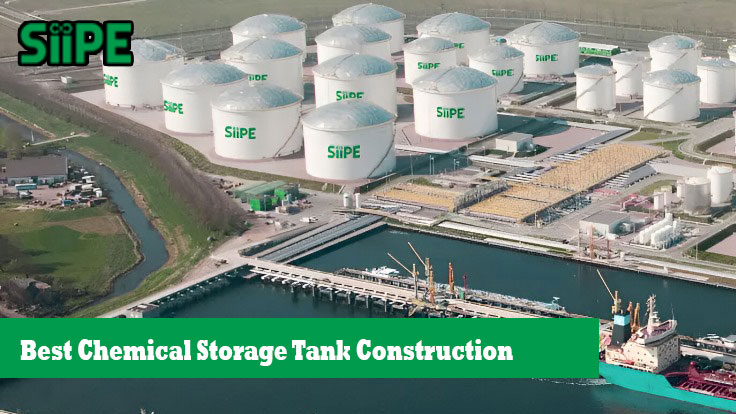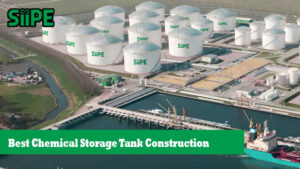In the realm of industrial operations, chemical storage tanks are pivotal for safely managing hazardous and non-hazardous chemicals. Selecting the best construction methods and companies is crucial for ensuring safety, efficiency, and longevity. This article explores ten of the best chemical storage tank constructions, with a special focus on Siipe.id, a standout provider in this field.
1. Siipe.id: A Leader in Chemical Storage Tank Construction
Siipe.id is renowned for its advanced chemical storage tank solutions. Known for its innovation and quality, Siipe.id offers customized tank designs tailored to meet the specific needs of various industries. Their commitment to safety, regulatory compliance, and durability sets them apart in the market.
Key Features:
- Custom Design: Tailors tanks to accommodate specific chemical properties and operational requirements.
- Advanced Materials: Utilizes high-quality materials such as stainless steel, FRP, and polyethylene.
- Safety Compliance: Adheres to stringent safety and environmental regulations.
2. Veolia Water Technologies
Veolia Water Technologies is a prominent name in chemical storage tank construction, particularly in the water treatment sector. Their tanks are designed to handle a wide range of chemicals used in water purification processes.
Key Features:
- Durability: Uses corrosion-resistant materials to ensure long-term performance.
- Advanced Coatings: Applies protective coatings to enhance tank longevity.
- Custom Solutions: Offers tailored solutions for diverse chemical storage needs.
3. Tank Connection
Tank Connection is a global leader in manufacturing and engineering storage tanks, including those for chemicals. Their expertise in tank design and construction ensures high-quality and reliable storage solutions.
Key Features:
- Modular Construction: Provides modular tank designs that can be customized and scaled according to requirements.
- High-Quality Materials: Employs materials like carbon steel and stainless steel for robust construction.
- Innovative Technology: Integrates advanced technology for leak detection and monitoring.
4. L.F. Manufacturing
L.F. Manufacturing is known for its chemical storage tanks that combine innovation with reliability. Their tanks are designed for various industries, including petrochemical and pharmaceutical.
Key Features:
- Robust Design: Focuses on durability and resistance to harsh chemical environments.
- Safety Features: Includes secondary containment systems to prevent leaks.
- Custom Engineering: Offers custom tank designs based on specific chemical properties and usage.
5. CST Industries
CST Industries specializes in the construction of storage tanks for chemicals and other industrial applications. Their tanks are known for their strength and versatility.
Key Features:
- Glass-Fused-to-Steel Tanks: Provides superior corrosion resistance and durability.
- Modular Design: Allows for flexibility in tank size and configuration.
- Advanced Engineering: Utilizes advanced engineering techniques to ensure tank integrity and safety.
6. Southern Tank
Southern Tank offers a range of chemical storage solutions, with a focus on durability and compliance. Their tanks are used in various industries, including agriculture and manufacturing.
Key Features:
- Versatile Designs: Provides tanks that can handle a wide range of chemicals and temperatures.
- Quality Assurance: Emphasizes strict quality control measures during construction.
- Customer Support: Offers comprehensive support and maintenance services.
7. Pfaudler
Pfaudler is a leading provider of chemical storage tanks, particularly known for its expertise in the pharmaceutical and chemical processing industries.
Key Features:
- Glass-Lined Tanks: Specializes in glass-lined tanks that offer excellent chemical resistance.
- High Standards: Adheres to high manufacturing standards and regulatory requirements.
- Custom Solutions: Provides custom-engineered tanks for specific chemical applications.
8. Emco Waterworks
Emco Waterworks focuses on water and chemical storage solutions, offering tanks that are designed to meet the rigorous demands of industrial applications.
Key Features:
- Durable Construction: Uses high-strength materials for long-lasting performance.
- Innovative Design: Integrates innovative design features for enhanced functionality.
- Regulatory Compliance: Ensures compliance with industry regulations and standards.
9. Prominent Fluid Controls
Prominent Fluid Controls is known for its expertise in chemical storage solutions, offering tanks that are used in various industrial and commercial applications.
Key Features:
- Precision Engineering: Provides precision-engineered tanks for accurate chemical handling.
- Quality Materials: Utilizes high-quality materials to ensure reliability and safety.
- Comprehensive Services: Offers a range of services, including installation and maintenance.
10. STI/SPFA
STI/SPFA is a leading organization in the storage tank industry, providing a wide range of chemical storage solutions that are known for their durability and performance.
Key Features:
- Steel Tanks: Specializes in steel tanks that offer robust and reliable storage solutions.
- Advanced Engineering: Incorporates advanced engineering techniques for enhanced tank performance.
- Industry Expertise: Leverages extensive industry expertise to deliver high-quality products.
Chemical storage tanks are critical components in industries dealing with hazardous or corrosive materials. Their construction and maintenance are paramount to ensuring operational safety, environmental protection, and cost-effectiveness.
This article explores the best practices and considerations in chemical storage tank construction, highlighting key factors that contribute to their effectiveness and longevity.
1. Understanding the Requirements
Before embarking on the construction of a chemical storage tank, it’s essential to understand the specific requirements of the chemicals to be stored. Different chemicals have varying properties, including corrosiveness, flammability, and temperature sensitivity, which influence tank design and material selection.
Key Considerations:
- Chemical Properties: Analyze the chemical’s pH, temperature, and reactivity to select appropriate materials and design parameters.
- Storage Capacity: Determine the volume of chemical required and ensure the tank size accommodates both current and future needs.
- Regulatory Compliance: Ensure the design complies with local, national, and international regulations and standards for chemical storage.
2. Choosing the Right Materials
Selecting the appropriate materials for construction is critical for the durability and safety of chemical storage tanks. The materials must withstand the chemical’s properties and environmental conditions without degrading over time.
Common Materials:
- Stainless Steel: Often used for its resistance to corrosion and ability to handle a wide range of chemicals. Types such as 304 and 316 stainless steel are popular choices.
- Fiberglass Reinforced Plastic (FRP): Ideal for corrosive chemicals and varying temperature conditions. FRP tanks are lightweight and resistant to rust and corrosion.
- Polyethylene: Suitable for certain chemicals and used in various industrial applications. It’s cost-effective and offers good resistance to impact and chemicals.
- Carbon Steel: Used for non-corrosive chemicals or those treated with protective coatings. It is less expensive but requires proper maintenance and coatings to prevent corrosion.
3. Designing for Safety and Efficiency
The design of a chemical storage tank must prioritize safety and operational efficiency. Proper design helps in preventing accidents, ensuring easy maintenance, and facilitating optimal performance.
Design Features to Consider:
- Secondary Containment: Incorporate a secondary containment system to capture spills or leaks, protecting the environment and personnel. This can be achieved through dikes, double-walled tanks, or bunded areas.
- Ventilation: Ensure proper ventilation to prevent the accumulation of hazardous fumes or vapors. Venting systems should be designed to handle the specific chemicals stored.
- Temperature Control: Depending on the chemical, temperature control systems may be necessary to maintain safe storage conditions and prevent chemical degradation or reactions.
- Access and Maintenance: Design the tank with easy access for maintenance, inspection, and cleaning. This includes access points, inspection ports, and drain valves.
4. Construction and Installation
The construction process involves meticulous planning and execution to ensure the tank meets all safety, performance, and regulatory requirements.
Construction Steps:
- Site Preparation: Prepare the site by assessing the soil conditions and ensuring a stable foundation. Proper drainage and groundwork are essential to support the tank and prevent settling.
- Foundation: Construct a robust foundation to support the weight of the tank and any additional equipment. The foundation should be designed to handle the load and potential chemical spillage.
- Tank Assembly: Assemble the tank components following design specifications and material requirements. Ensure all welds, joints, and fittings are properly executed to prevent leaks.
- Testing and Inspection: Conduct thorough testing, including hydrostatic tests and visual inspections, to verify the tank’s integrity and performance before it goes into service.
5. Maintenance and Monitoring
Regular maintenance and monitoring are crucial for extending the lifespan of a chemical storage tank and ensuring it remains safe and efficient.
Maintenance Practices:
- Routine Inspections: Perform regular inspections to identify signs of wear, corrosion, or damage. Inspections should include checking for leaks, structural integrity, and the condition of protective coatings.
- Cleaning and Decontamination: Clean and decontaminate tanks periodically to remove residues and prevent contamination. Follow proper procedures to handle hazardous materials during cleaning.
- Monitoring Systems: Implement monitoring systems to track chemical levels, temperature, and pressure. Automated systems can provide real-time data and alert operators to potential issues.
6. Regulatory and Safety Compliance
Compliance with regulatory standards is essential for the safe and legal operation of chemical storage tanks. Adhering to these regulations helps prevent accidents, environmental damage, and legal liabilities.
Regulatory Standards:
- Occupational Safety and Health Administration (OSHA): Follow OSHA guidelines for chemical safety, including proper tank labeling, emergency procedures, and worker training.
- Environmental Protection Agency (EPA): Comply with EPA regulations for spill containment, waste management, and environmental protection.
- International Standards: Adhere to international standards such as those from the American Petroleum Institute (API) and the National Fire Protection Association (NFPA) for tank design and safety.
7. Innovations and Future Trends
The field of chemical storage tank construction continues to evolve with advancements in materials, technology, and design practices.
Emerging Trends:
- Advanced Materials: Research and development are leading to new materials with enhanced resistance to extreme conditions and chemical interactions.
- Smart Tanks: Integration of IoT and smart technologies allows for real-time monitoring, predictive maintenance, and automated safety systems.
- Sustainability: Emphasis on sustainability and eco-friendly practices is driving innovations in tank construction, including the use of recyclable materials and energy-efficient systems.
Consider Clearly
The construction of chemical storage tanks involves careful consideration of materials, design, construction practices, and maintenance to ensure safety, efficiency, and longevity. By adhering to best practices and staying informed about industry advancements, companies can optimize their chemical storage solutions and protect both their operations and the environment.
In summary, selecting the right materials, designing for safety and efficiency, and maintaining rigorous standards for construction and upkeep are fundamental to the successful operation of chemical storage tanks. Embracing innovations and regulatory requirements further enhances tank performance and reliability, making it possible to meet the demands of modern industries while safeguarding public health and the environment.










